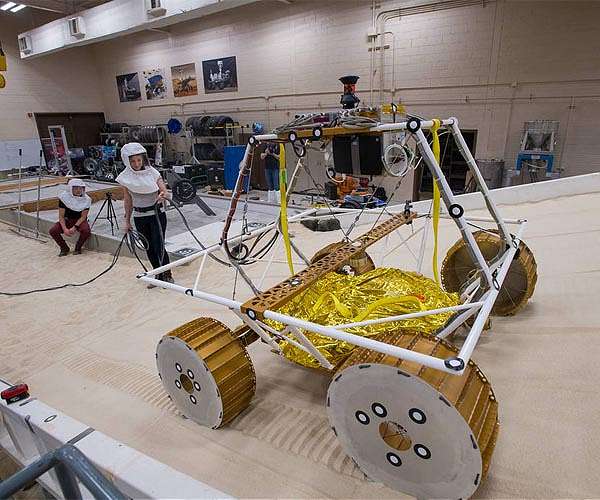Artificial Intelligence and NASA's First Robotic Lunar Rover
 When NASA's VIPER (short for Volatiles Investigating Polar Exploration Rover) lands on the surface of the Moon on a mission to better understand the environment where NASA plans to send astronauts as part of the increasingly complex Artemis missions, its journey will be guided by the ingenuity of its human team - and several key tools that use artificial intelligence. From helping the science team choose a landing site at the lunar mountain Mons Mouton, to planning out its path, the VIPER team has developed and used artificial intelligence algorithms to help assess risk and optimize decision making.
When NASA's VIPER (short for Volatiles Investigating Polar Exploration Rover) lands on the surface of the Moon on a mission to better understand the environment where NASA plans to send astronauts as part of the increasingly complex Artemis missions, its journey will be guided by the ingenuity of its human team - and several key tools that use artificial intelligence. From helping the science team choose a landing site at the lunar mountain Mons Mouton, to planning out its path, the VIPER team has developed and used artificial intelligence algorithms to help assess risk and optimize decision making.
Artificial intelligence is a wide field, and the resulting techniques are still far from the self-aware robots of science fiction. Instead, the field contributes tools to help space missions deal with some of the uncertainties that come with planning and executing a real-time mission in a challenging, largely unexplored environment.
"AI allows VIPER to be more adaptable, flexible, resilient, and efficient," said Edward Balaban, VIPER's lead for strategic planning at NASA's Ames Research Center in California's Silicon Valley. "It's a tool that allows us to use change as a strength."
These tools don't replace human input - NASA scientists design these systems in the first place, input the relevant data, and then use the AI's outputs as a baseline for mission-related decisions. During VIPER mission operations, the team plans to use AI interactively to help map out various routes for the operations team members to choose from. This AI system is called SHERPA - the System Health Enabled Real-time Planning Advisor.
Traversing the Lunar Surface
The VIPER mission will run for about 100 days after landing on Mons Mouton near the lunar South Pole. Throughout its journey, VIPER will make many stops at several science stations - sites selected for their potential to achieve the mission's science objectives. These objectives include understanding the factors that control the distribution of water on the surface of the Moon, understanding the delivery history of water to the Moon, determining the origin of lunar water and other , and determining how volatiles evolve over time after they are deposited on the surface.
How the rover moves from one of these sites to the other, and where it can find a safe place, referred to as a "safe haven," to pause while temporarily out of communications with Earth - without getting stuck in an extremely cold and dark shadow - is a complex question requiring analysis of vast amounts of data. Factors such as the Moon's rugged terrain, VIPER's needs and limits, and the potential of the various science stations all need to be considered.
SHERPA is able to process all these factors and present the VIPER team with several options while planning the rover's traverse before mission operations. It can assess the various risks of different routes by running thousands of mission simulations, and even provide contingency branches for where to go if something changes or doesn't go according to plan. But after launch, SHERPA's work won't be over - it'll also be used for real-time, dynamic problem solving, giving the VIPER team potential solutions to adjust the rover's traverse when it's presented with new scientific or operational information.
A traverse from SHERPA isn't just a one-and-done plan. The AI will provide a template that humans consider and revise. Any changes made are then run back through SHERPA to determine if it's feasible or if there are any issues. Those revisions won't be corrections in the traditional sense or enacted by default, but allow team members to make adjustments based on factors the AI may not be able to consider, such as constraints related to staffing for the team members driving the rover or operating the rover science instruments.
Another set of techniques from a subfield of AI known as temporal constraint planning helps VIPER make its to-do list, by essentially presenting an algorithm with the problem of scheduling a set of activities within a certain time.
***
Image: During VIPER mission operations, the team plans to use AI interactively to help map out various routes for the operations team members to choose from. This AI system is called SHERPA - the System Health Enabled Real-time Planning Advisor. Credit: NASA
Source: Space Daily



